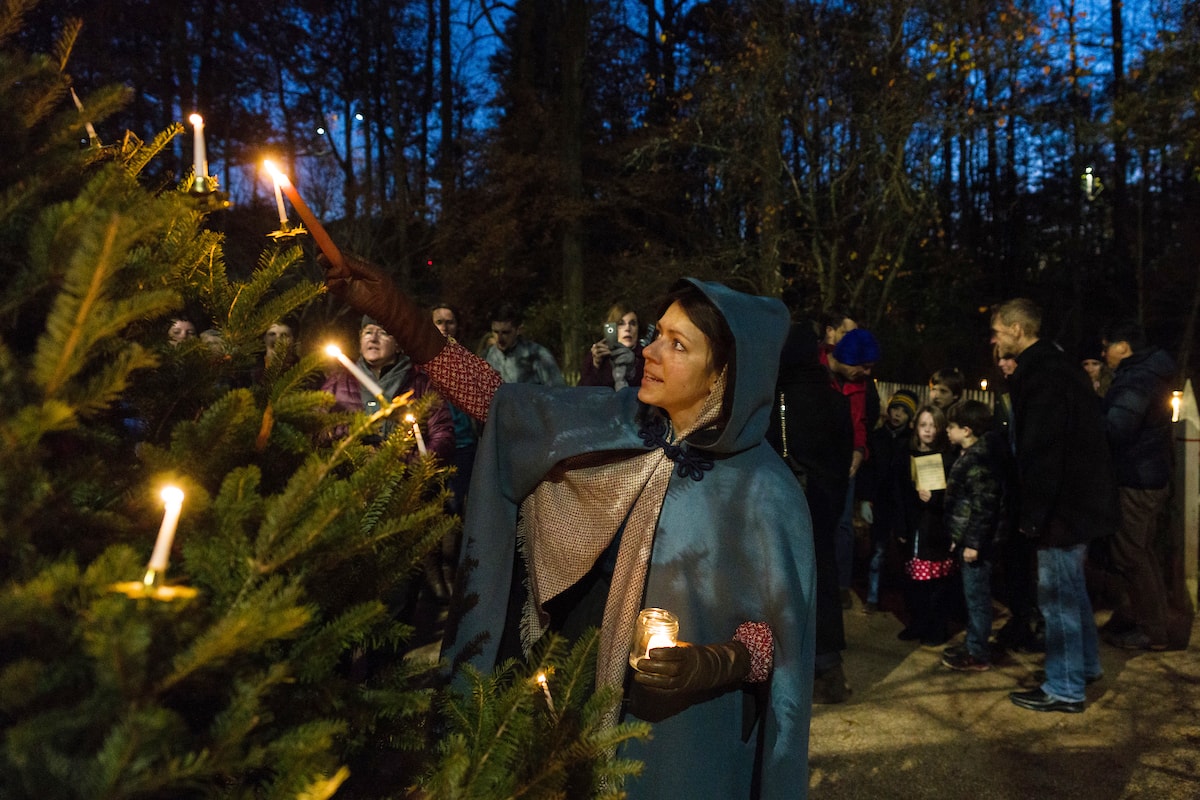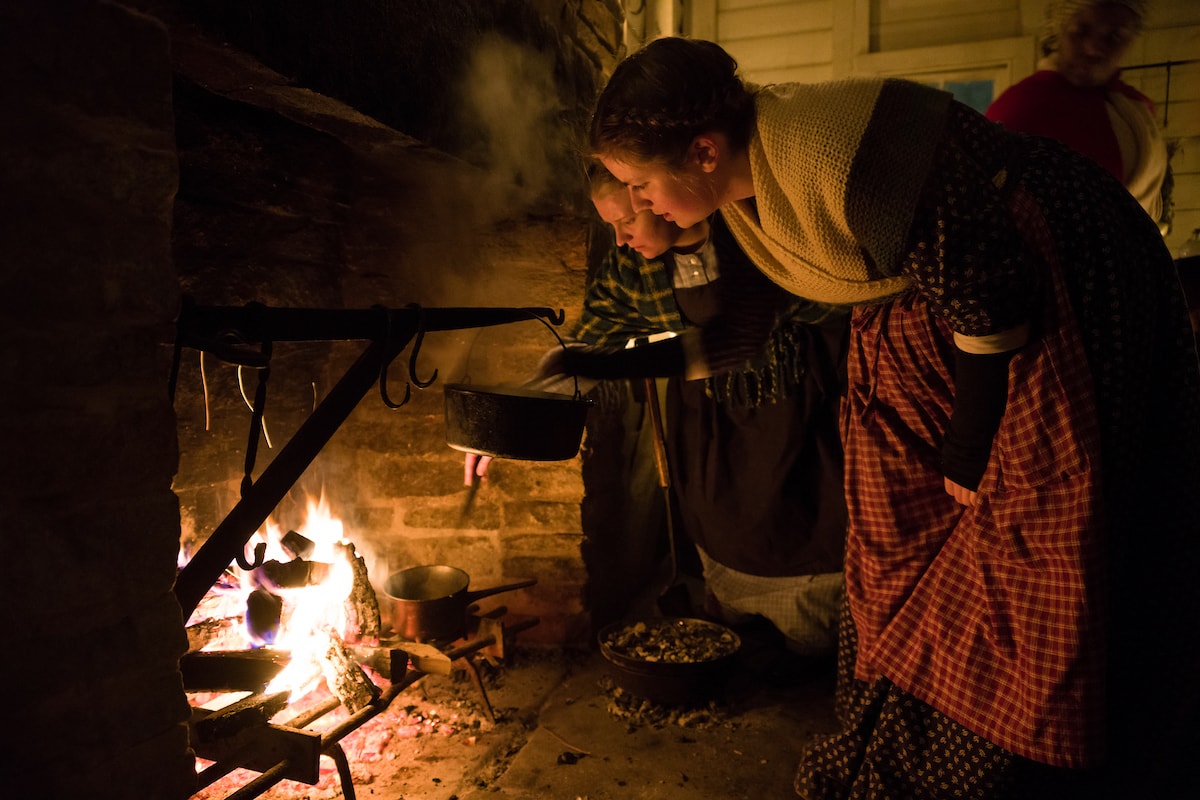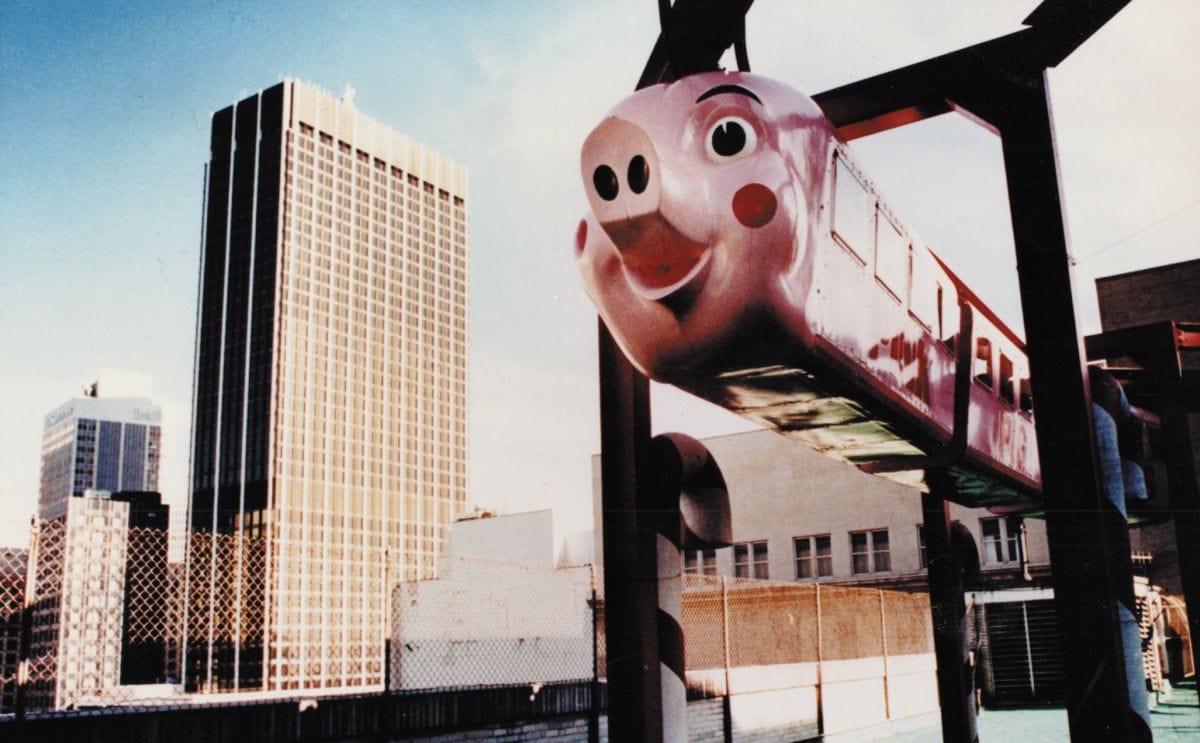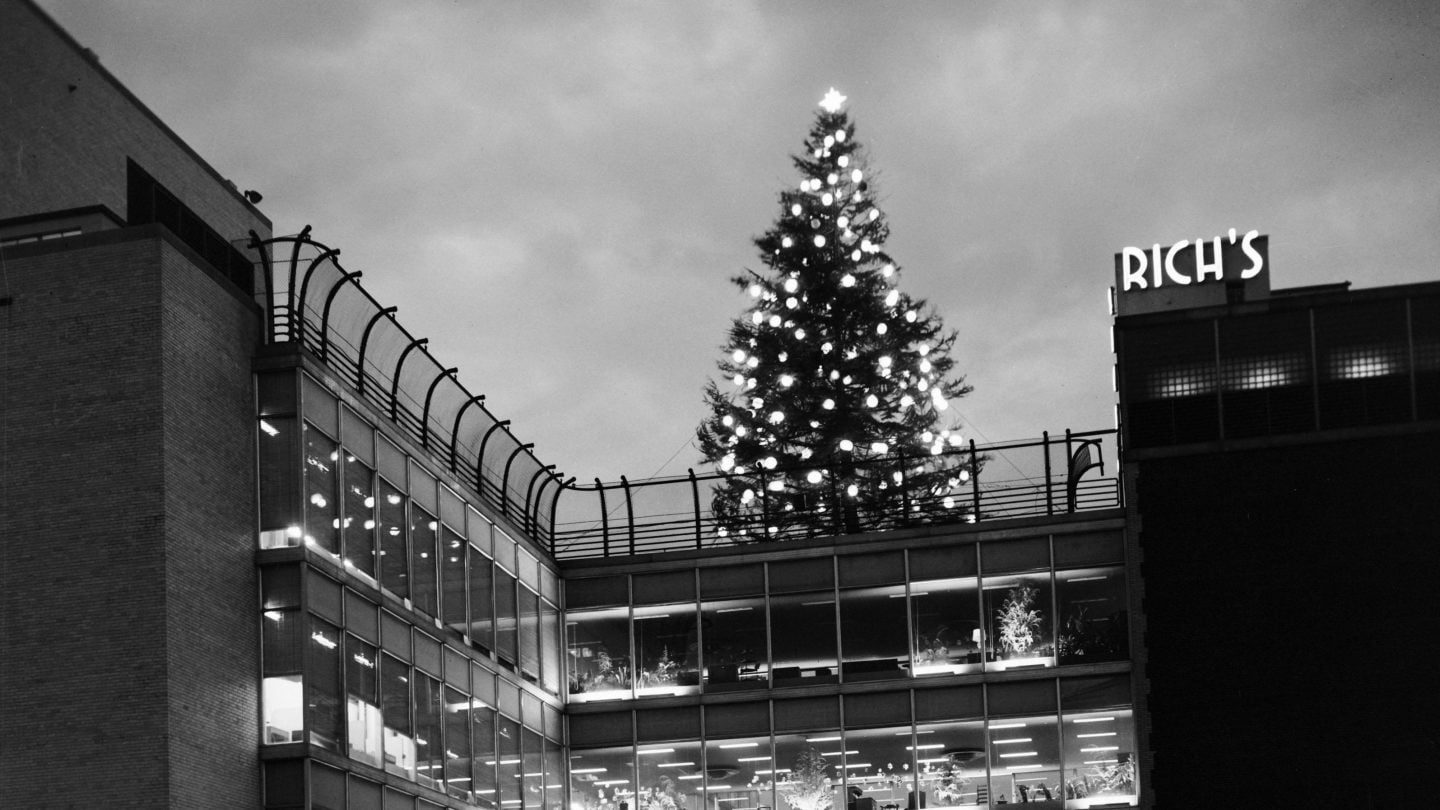
A caroler lights a Christmas tree on Smith Farm the old fashioned (and flammable) way.
In Atlanta, different cultures come together to create unique holiday experiences.
To celebrate this festive season, we’ve gathered together some historic holiday traditions to share with you and yours.
Holiday Decorations & The Christmas Tree
When the first European settlers arrived in North America, their biggest concern was with survival, not decking the halls. In the 18th and 19th centuries, holidays were much more laid back than they are today. Emphasis would have been placed on togetherness, family, and—if you had the means—a holiday feast. Gift-giving and decorating weren’t yet customary.
Until the mid-20th century, anytime Atlantans did decide to decorate for the holiday season, they had to do it with whatever they had in their back yards. There were no big box stores selling pre-lit Christmas trees or faux garland. What grew on your land (or what you could purchase from your neighbors) was what you used. Pine, cedar, and magnolia were abundant throughout Atlanta and north Georgia, which meant that they were the de facto decoration for mantles, doorways, dining rooms, and wherever else.
When it came to Christmas trees, people thought very little of them—literally. Throughout the 19th century, Christmas trees remained small enough to fit on a family’s dining room table. In the image above, we see what trees had started to become by the 1890s—fire hazards. Because there were no electric string lights, folks illuminated their trees with candles placed on the outermost branches, or on wooden hoops that encircled the trunk. If that sounds dangerous, that’s because it was. A fire bucket filled with sand was never far away when the candles were lit. For obvious reasons, families had to be constantly vigilant while basking in the yuletide glow.

Cooking Christmas dinner over the yule log was a European tradition remade in America.
The Yule Log
The log has a much older history, originating in the Iron Age as an integral part of winter solstice celebrations in western Europe. As the year drew to a close, families burned massive logs in order to cleanse the air of the previous year’s events. These logs would have been highly decorated with ivy, holly, and other botanicals. It was said that the ashes of a burned yule log could protect the bearer from lightning strikes.
As Christianity rose in popularity, the yule log endured. Families would burn a smaller yule log in their cooking hearths on Christmas Eve and use the fire’s heat to cook Christmas dinner.
When the tradition came to the United States in the 19th century, it comingled with other New World traditions and took on an Americanized life all its own. It became customary across parts of the antebellum South for plantation owners to provide enslaved peoples a yule log. Booker T. Washington wrote about the yule log in his autobiography, Up from Slavery. Formerly enslaved men and women detailed their Christmas traditions in the thousands of hours of oral histories housed at the Library of Congress.
On some plantations, enslaved individuals weren’t required to work as for as long as the log burned in the hearth. In instances when the enslaved individuals could cut the log themselves, they would choose the largest, slowest burning trees available—sweetgum, for instance. To further extend the life of the flame, water would be sprinkled on the log as it burned. Jenny Proctor—one of 300 enslaved women on an Alabama plantation—recounted that a well-chosen log could burn for up to three days. She also remembered the plantation owner adding fast-burning pine knots to the blaze when the fire lasted too long for his liking.
Chocolate Gelt
Nowadays, we know gelt as the waxy chocolate coins wrapped in foil given to Jewish children during Hanukkah. They’re more nostalgic than they are delicious. Historically, however, gelt was real coinage.
This tradition comes from the shtetls, or villages, of Eastern Europe. There was a tradition in these small communities of giving year-end tips to itinerant workers. Butchers, teachers, and the person employed by the synagogue to round up villagers for evening prayer all were among those who received some extra compensation during Hanukkah.
According to Gina Glasman, professor of Judaic Studies at Binghamton University, as families relocated from their countryside shtetls into towns and cities, traditions shifted. The tradition of minting specialty coins for charitable giving or Purim celebrations morphed with the Hanukkah holiday—which was, itself, in flux. At the end of the 19th century, families shifted away from tipping these auxiliary laborers and began giving small gifts to their own children.
With the arrival of Jewish immigrants to the United States, Hanukkah traditions were again reshaped. The influence of gift-giving and commercialization of Christmas comingled with Jewish customs. In the mid-20th century, these coins made the jump from metal to confectionery.
While the tradition looks different today—the waxy gelt of childhood replaced with fair-trade, high-end substitutes—its roots remain firmly in a history of goodwill and charity.

We’d tell you to buckle up, but the Pink Pig didn’t have seat belts.
The Pink Pig + Rich’s
From 1948 until 1991, Christmas in Atlanta wasn’t complete without the Great Tree and the Pink Pig. These two icons symbolized the start of the holiday seasons for Atlantans and gave reason for folks to flock to Rich’s Department Store for their holiday shopping.
Devised as a marketing tactic to draw folks into downtown from the suburbs, the Great Tree, a 70-ft live Christmas tree, was first illuminated at the Rich’s flagship store in 1948. The fully-decorated tree could be seen for miles outside of the city center and became an instant tourist attraction. It originally loomed over the corner of Hunter and Alabama Streets, then migrated to sit atop the Crystal Bridge on Forsyth Street. The tree lighting ceremony took place every Thanksgiving and drew hundreds of thousands of views both in person and on television. The tree became such a recognizable symbol that Time Magazine featured it on their December 15, 1961, cover.
Over time, Rich’s fully embraced their title as a Christmas destination. In the 1950s, the holiday display began on the department store’s ground level and spiraled up all six floors to the roof. Parents brought their children to the rooftop Christmas village, which hosted live reindeer, a model of Santa’s Workshop, and Rich’s famous Pink Pigs.

The Great Tree atop Rich’s Crystal Bridge on Forsyth Street.
In 1953, Rich’s debuted Priscilla the Pig—a small monorail that originally ran around the toy department. Two years later, Rich’s reconfigured her track to send riders out of toyland and onto the roof to get an up-close look at the Great Tree. A second pig, Percival, joined the team in 1964. Costing only a quarter to ride, the twin Pink Pigs provided an easy distraction for children, both naughty and nice, and a momentary reprieve for exhausted parents.
When Rich’s shut its doors in 1991, Priscilla and Percival travelled briefly to the Egleston Children’s Hospital’s Festival of Trees before retiring to Atlanta History Center. Each year, we loan one of the twins back to Macy’s at Lenox Square Mall for the holiday season.

